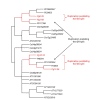A spruce gene map infers ancient plant genome reshuffling and subsequent slow evolution in the gymnosperm lineage leading to extant conifers
- PMID: 23102090
- PMCID: PMC3519789
- DOI: 10.1186/1741-7007-10-84
A spruce gene map infers ancient plant genome reshuffling and subsequent slow evolution in the gymnosperm lineage leading to extant conifers
Abstract
Background: Seed plants are composed of angiosperms and gymnosperms, which diverged from each other around 300 million years ago. While much light has been shed on the mechanisms and rate of genome evolution in flowering plants, such knowledge remains conspicuously meagre for the gymnosperms. Conifers are key representatives of gymnosperms and the sheer size of their genomes represents a significant challenge for characterization, sequencing and assembling.
Results: To gain insight into the macro-organisation and long-term evolution of the conifer genome, we developed a genetic map involving 1,801 spruce genes. We designed a statistical approach based on kernel density estimation to analyse gene density and identified seven gene-rich isochors. Groups of co-localizing genes were also found that were transcriptionally co-regulated, indicative of functional clusters. Phylogenetic analyses of 157 gene families for which at least two duplicates were mapped on the spruce genome indicated that ancient gene duplicates shared by angiosperms and gymnosperms outnumbered conifer-specific duplicates by a ratio of eight to one. Ancient duplicates were much more translocated within and among spruce chromosomes than conifer-specific duplicates, which were mostly organised in tandem arrays. Both high synteny and collinearity were also observed between the genomes of spruce and pine, two conifers that diverged more than 100 million years ago.
Conclusions: Taken together, these results indicate that much genomic evolution has occurred in the seed plant lineage before the split between gymnosperms and angiosperms, and that the pace of evolution of the genome macro-structure has been much slower in the gymnosperm lineage leading to extent conifers than that seen for the same period of time in flowering plants. This trend is largely congruent with the contrasted rates of diversification and morphological evolution observed between these two groups of seed plants.
Figures






References
-
- Lynch M. The origins of genome architecture. Sunderland, MA: Sinauer Associates; 2007.
-
- Li WH. In: Evolution of Genes and Proteins. Nei M, Koehin RK, editor. Sunderland, MA: Sinauer Associates; 1983. Evolution of duplicated genes; pp. 14–37.
Publication types
MeSH terms
Substances
LinkOut - more resources
Full Text Sources

